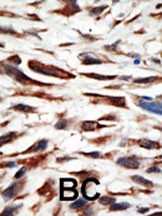SET1 Antibody (N-term)
Purified Rabbit Polyclonal Antibody (Pab)
- 产品详情
- 文献引用 : 1
- 实验流程
- 背景知识
Application
| IHC-P, E |
|---|---|
| Primary Accession | O15047 |
| Reactivity | Human |
| Host | Rabbit |
| Clonality | Polyclonal |
| Isotype | Rabbit IgG |
| Calculated MW | 186034 Da |
| Gene ID | 9739 |
|---|---|
| Other Names | Histone-lysine N-methyltransferase SETD1A, Lysine N-methyltransferase 2F, SET domain-containing protein 1A, hSET1A, Set1/Ash2 histone methyltransferase complex subunit SET1, SETD1A |
| Target/Specificity | This SET1 antibody is generated from rabbits immunized with a KLH conjugated synthetic peptide selected from the N-terminal region of human SET1. |
| Dilution | IHC-P~~1:100~500 E~~Use at an assay dependent concentration. |
| Format | Purified polyclonal antibody supplied in PBS with 0.09% (W/V) sodium azide. This antibody is prepared by Saturated Ammonium Sulfate (SAS) precipitation followed by dialysis against PBS. |
| Storage | Maintain refrigerated at 2-8°C for up to 2 weeks. For long term storage store at -20°C in small aliquots to prevent freeze-thaw cycles. |
| Precautions | SET1 Antibody (N-term) is for research use only and not for use in diagnostic or therapeutic procedures. |
| Name | SETD1A |
|---|---|
| Function | Histone methyltransferase that catalyzes methyl group transfer from S-adenosyl-L-methionine to the epsilon-amino group of 'Lys-4' of histone H3 (H3K4) via a non-processive mechanism (PubMed:12670868, PubMed:25561738). Part of chromatin remodeling machinery, forms H3K4me1, H3K4me2 and H3K4me3 methylation marks at active chromatin sites where transcription and DNA repair take place (PubMed:29937342, PubMed:31197650, PubMed:32346159). Responsible for H3K4me3 enriched promoters and transcriptional programming of inner mass stem cells and neuron progenitors during embryogenesis (By similarity) (PubMed:31197650). Required for H3K4me1 mark at stalled replication forks. Mediates FANCD2-dependent nucleosome remodeling and RAD51 nucleofilaments stabilization at reversed forks, protecting them from nucleolytic degradation (PubMed:29937342, PubMed:32346159). Does not methylate 'Lys-4' of histone H3 if the neighboring 'Lys-9' residue is already methylated (PubMed:12670868). Binds RNAs involved in RNA processing and the DNA damage response (PubMed:38003223). |
| Cellular Location | Nucleus speckle. Chromosome Cytoplasm. Note=Localizes to a largely non-overlapping set of euchromatic nuclear speckles with SETD1B, suggesting that SETD1A and SETD1B each bind to a unique set of target genes (PubMed:17355966). Predominantly nuclear (PubMed:38003223) |
For Research Use Only. Not For Use In Diagnostic Procedures.

Provided below are standard protocols that you may find useful for product applications.
BACKGROUND
Similar to acetylation and phosphorylation, histone methylation at the N-terminal tail has emerged as an important role in regulating chromatin dynamics and gene activity. Histone methylation occurs on arginine and lysine residues and is catalyzed by two families of proteins, the protein arginine methyltransferase family and the SET-domain-containing methyltransferase family. Five members have been identified in the arginine methyltransferase family. About 27 are grouped into the SET-domain family, and another 17 make up the PR domain family that is related to the SET domain family. The retinoblastoma protein-interacting zinc finger geneRIZ1 is a tumor suppressor gene and a FOUNDING member of the PR domain family. RIZ1 inactivation is commonly found in many types of human cancers and occurs through loss of mRNA expression, frame shift mutation, chromosomal deletion, and missense mutation. RIZ1 is also a tumor susceptibility gene in mice. The loss of RIZ1 mRNA in human cancers was shown to associate with DNA methylation of its promoter CpG island. Methylation of the RIZ1 promoter strongly correlated with lost or decreased RIZ1 mRNA expression in breast, liver, colon, and lung cancer cell lines as well as in liver cancer tissues.
REFERENCES
Nagase, T., et al., DNA Res. 4(2):141-150 (1997).
终于等到您。ABCEPTA(百远生物)抗体产品。
点击下方“我要评价 ”按钮提交您的反馈信息,您的反馈和评价是我们最宝贵的财富之一,
我们将在1-3个工作日内处理您的反馈信息。
如有疑问,联系:0512-88856768 tech-china@abcepta.com.






















 癌症的基本特征包括细胞增殖、血管生成、迁移、凋亡逃避机制和细胞永生等。找到癌症发生过程中这些通路的关键标记物和对应的抗体用于检测至关重要。
癌症的基本特征包括细胞增殖、血管生成、迁移、凋亡逃避机制和细胞永生等。找到癌症发生过程中这些通路的关键标记物和对应的抗体用于检测至关重要。 为您推荐一个泛素化位点预测神器——泛素化分析工具,可以为您的蛋白的泛素化位点作出预测和评分。
为您推荐一个泛素化位点预测神器——泛素化分析工具,可以为您的蛋白的泛素化位点作出预测和评分。 细胞自噬受体图形绘图工具为你的蛋白的细胞受体结合位点作出预测和评分,识别结合到自噬通路中的蛋白是非常重要的,便于让我们理解自噬在正常生理、病理过程中的作用,如发育、细胞分化、神经退化性疾病、压力条件下、感染和癌症。
细胞自噬受体图形绘图工具为你的蛋白的细胞受体结合位点作出预测和评分,识别结合到自噬通路中的蛋白是非常重要的,便于让我们理解自噬在正常生理、病理过程中的作用,如发育、细胞分化、神经退化性疾病、压力条件下、感染和癌症。






